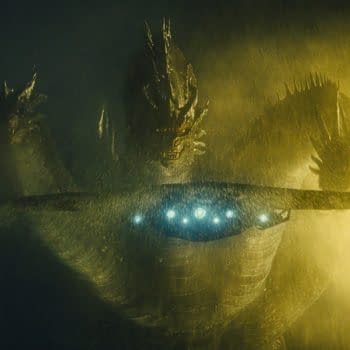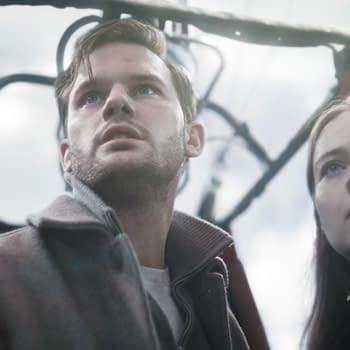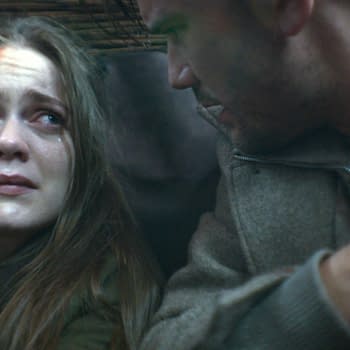Posted in: Movies, Trailer | Tagged: charlie hunnam, film, jude law, king arthur, king arthur: legend of the sword, movie, Review
Review: King Arthur: Legend Of The Sword Takes The Story On A High Fantasy Spin… And It Works
Ever since the first trailer for King Arthur: Legend of the Sword was shown back in Hall H at 2016's San Diego Comic-Con, I've been looking forward to being able to flip tables and rail against the latest Guy Ritchie film. It's not inherently because it's a Ritchie film, either, as many of his projects have solid, enjoyable productions. However, the sight of Sons of Anarchy star Charlie Hunnam speed-racing through the streets of Londinium wearing what appears to be Bane's jacket from The Dark Knight Rises made my inner history geek cringe at the very thought.
Imagine my utter shock when scene after scene rolls by and it occurs to me that this isn't actually bad at all, but a rather clever spin on the whole Knights of the Round Table series of legends.
I have to consider that this year's Great Wall probably felt about the same to a Chinese viewer as watching Arthur was for myself (Matt Damon notwithstanding). Now, granted, the telling this time around has only the most fleeting of resemblance to the stories of Geoffrey of Monmouth — but it does have more elements than 2004's King Arthur, which starred Clive Owen and Kiera Knightley.
This time around, the film opens with a war raging between Mordred as the leader of the Mages (who are presented as a whole tribe of sorcerers) and Uther Pendragon (played by Eric Bana). The fight has come down to Uther leading a final defense at his castle at Camelot. Mordred has summoned massive stone-golem elephants as mobile strike platforms and is coming down to crush Uther once and for all. Uther breaks out the sword Excalibur and carries the day, only to have his brother, Vortigern (Jude Law), betray and murder him. But before he meets his fate, Uther is able to send his young son Arthur away in a boat. Arthur manages to float away from Camelot to the Thames in Londinium, where he's discovered and taken in by a group of prostitutes washing their laundry.
Cut to 20-something years later, and Arthur has been raised by one of the women who found his craft all those years before. He's become a bouncer, petty gang leader, and dispenser of justice in his area of town. Rumors of the young king returning to claim the throne persist, and the waters around Camelot recede to once again reveal where the old king had lost the sword — it is now embedded into the bedrock. Soldiers scour the country, gathering up all males of the proper age and having each attempt to draw the sword. When Arthur finally arrives and places his hand on the sword's hilt, well, you know the rest. From there, things go south rather quickly.
Astrid Berges-Frisbey, the French-Spanish actress who was initially cast in the role of Guinevere, is now only referred to as Mage. Her powers are easily on par with most other magic-using characters that we've seen in fantasy films in recent years, and it's nice to see that given firmly to a woman rather than a straight-up Merlin-type.
The film itself is classic Ritchie, from the quick dialogue exchanges to scene jumping. It's a very modern approach to how the film is presented. It moves quickly, the action is solid, and the CGI is also pretty good (however, 3D-viewing doesn't really add anything to the experience). If you're a fan of fantasy, Ritchie, Hunnam, or Law, then give Arthur a try and you'll probably have a fun time. But if you're a stickler for your Arthur story to be of the classic variety, or just want Merlin with his chrome helmet, then perhaps you'll want to stick to staying home and watching Excalibur (granted, that film remains the definitive classic edition).
However, I couldn't fully end this review without touching on the historical side of things.
The random attempts at historical elements are so bewilderingly strange that it almost makes it fun to just watch for the elements that are juxtaposed. For example, they make every effort to call the main city Londinium, but at the same time identify themselves as living in England. There are wide shots of the city still having a strong Roman influence in its buildings (and the city more substantial than it would have ever been); however, since Vortigern places the timeline firmly in the late 5th century, the city would have been all but abandoned. They also have the local Coliseum in the background shots, but it's both far larger than the real one and exhibits the wrong kind of stonework (the film's version is modeled to look very much like the one from Rome, albeit a bit smaller).
Then there's the few scenes that involve Vikings. They're referred to specifically as Vikings, almost three centuries too early. Then there's the armor designs, of which were worn by no one anywhere at anytime outside of Pennsic.
The language and idioms are all entirely modern, with a few modern UK–English terms thrown in to sound kinda British. Accents are purely optional and tend to vary from scene to scene.
All that said, I'll go back to the original point: It's clear that this film was made with the intent to have fun with it, and that comes across throughout. It's not meant to be taken as either history lesson or a presentation of the classic legends. It's got giant snakes and eagles. Dungeon serpent-monsters who grant powers in exchange for a loved-one's blood. It's made for a good time, and somehow Ritchie has managed to do it without insulting the original material — and that's a pretty impressive feat by itself.
https://www.youtube.com/watch?v=bizo9AhuqdA







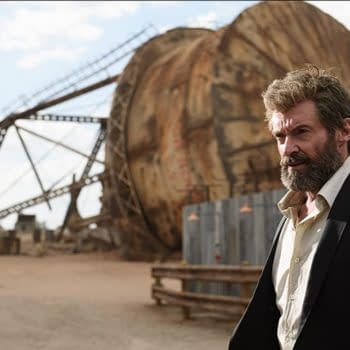
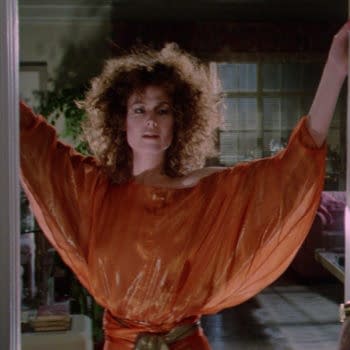
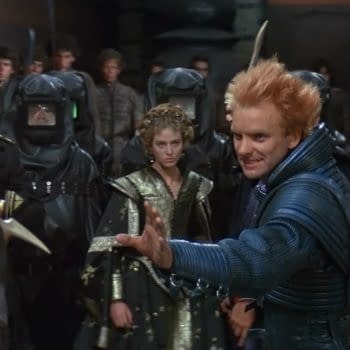
!['Rocketman' Soars With Warts and All Elton John Story [Review]](https://mlpnk72yciwc.i.optimole.com/cqhiHLc.IIZS~2ef73/w:350/h:350/q:75/rt:fill/g:ce/https://bleedingcool.com/wp-content/uploads/2019/01/rocketman.3-350x350.jpg)
